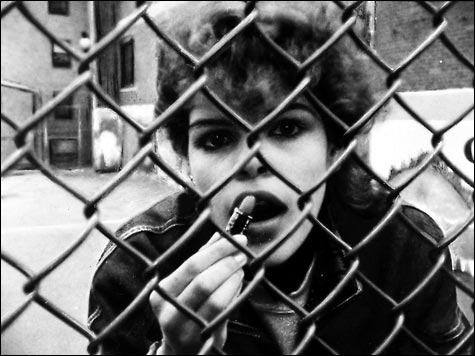
GIRLTALK: Kate Davis’s fabulous teen-chick documentary is at the Brattle April 30. |
For peddling some not-for-sale DVDs to a dubious Internet customer, local critic Paul Sherman found himself in the middle of an FBI sting, removed from his reviewing posts at the Boston Herald and the Improper Bostonian, and under voluntary house arrest. Down but not out, Sherman spent his incarceration compiling the Beantown book of books, Big Screen Boston: From Mystery Street to The Departed and Beyond. Self-published (Black Bars Publishing, May 1), this is an indispensable history/dictionary/catalogue/critique of local feature filmmaking through the years. Dramas. Documentaries. Hollywood features and many indies.
Fie on Toronto standing in for the Hub! With Sherman as guide, we’re talking Boston as Boston, from All the Rage (1997), a gay melodrama set in the South End about “an A-list Boston lawyer with money, looks, and libido,” to With Honors (1994), “a socially conscious campus drama [in which] interiors that are supposed to be the Widener Library take place inside the Boston Athenaeum.”
The latter film faced the difficulty of many Ivy League scenarios — shooting is verboten within the Harvard gates. I’d always heard that a 1980 film, A Small Circle of Friends, had precipitated the ban, because the production company had made artificial snow in Harvard Yard and ruined the grass. According to Sherman, the anti–Vietnam War picture was ejected for a different reason: conservative Harvard profs objected to a anti-war banner hung by the filmmakers in Memorial Hall. In Big Screen Boston, Sherman has many such stories. He’s read through the period newspapers and magazines; he’s interviewed many of the participants.
Who else could distinguish between Mervyn LeRoy’s Home Before Dark (1958), a “partially successful” Hollywood soaper set among the Marblehead ritzy with a shopping trip to Bonwit Teller’s on Berkeley Street, and Home Before Dark (1997), “a well-observed, bittersweet, coming-of-age story” by Cambridge writer/director Maureen Foley? Who else has the scoop on Love Story (1970), pointing out that one of Ryan O’Neal’s Harvard roommates is played by real-life Al Gore roomie Tommy Lee Jones? Or that Jones would become, also in real life, the first manager of Cambridge’s legendary arthouse, the Orson Welles Cinema?
The Mystery Street in Sherman’s title? It’s John Sturges’s 1950 studio thriller and, in the author’s view, the first time that Hollywood ventured to Boston for location shooting. Thanks for the alert, because this noir sounds in need of discovery, with the great cinematographer John Alton unleashed on a Beacon Hill rooming house.
You can read here about the works of Boston’s most important narrative directors, from Jan Egleson to Andrew Bujalski. But Sherman also covers our most important contribution to cinema: documentary making. The films of Rob Moss, Errol Morris, Frederick Wiseman, Richard Leacock, Ross McElwee are in here too.
Where to purchase? Visit www.BigScreenBoston.com, or go to Amazon. Or attend one of the upcoming book-release screenings that Sherman will be attending: Kate Davis’s fabulous teen-chick documentary Girltalk (1987), at the Brattle April 30; Jan Egleson’s indie-feature classics Billy in the Lowlands (1979) and The Dark End of the Street (1981), at, respectively, the Brattle May 1 and the West Newton May 21; Frederick Wiseman’s mental-institution masterpiece Titicut Follies (1967), May 3 at the MFA; and Peter Yates’s The Friends of Eddie Coyle (1973), the granddaddy of Boston mobster movies, June 5 at the Coolidge Corner. This last, from George V. Higgins’s novel, is Sherman’s all-time favorite, ahead of Mystic River and The Departed. He who has seen hundreds of them calls it “the best movie ever made in Boston.”